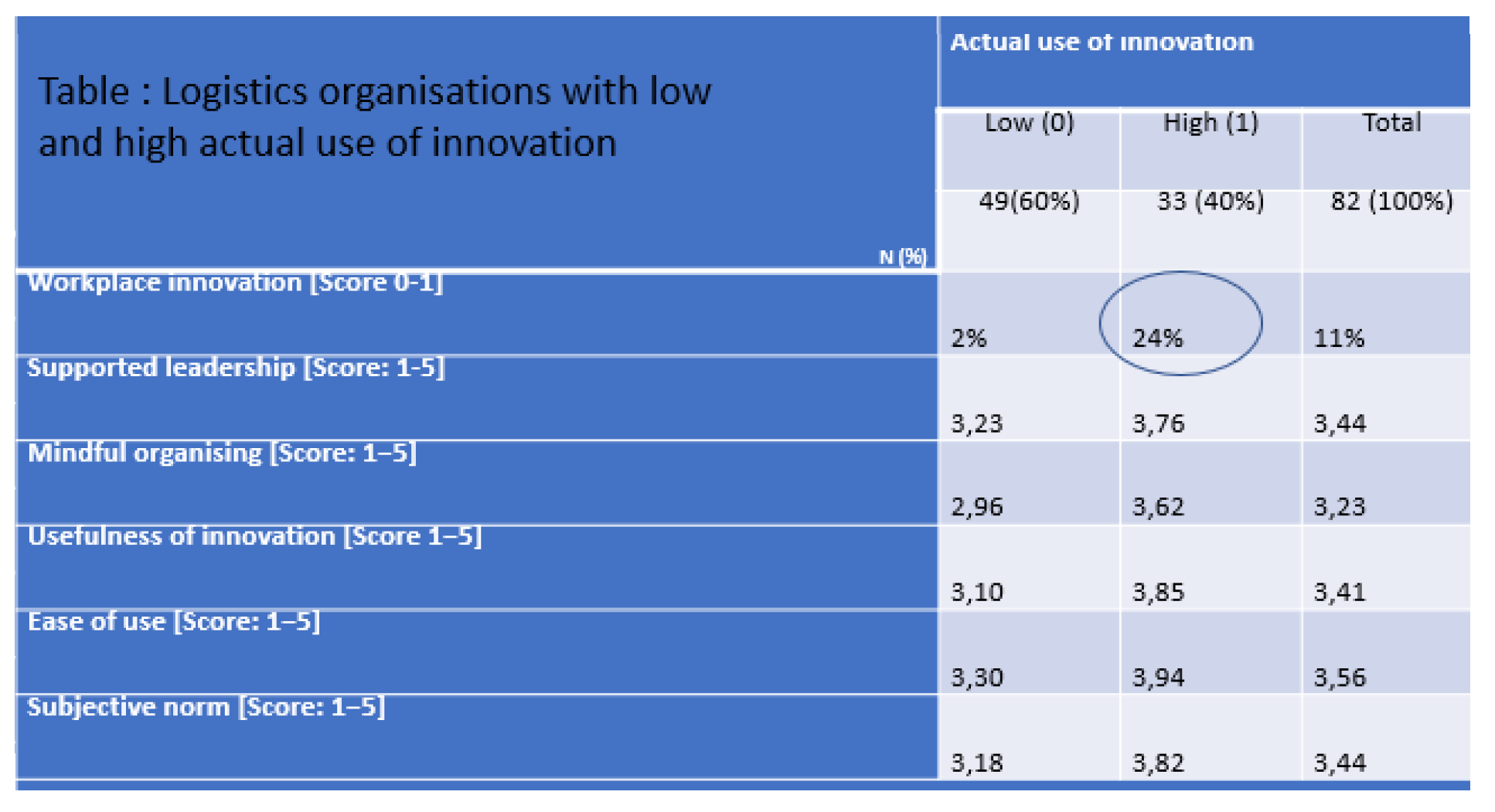How mindful organising and workplace innovation stimulate the adoption of innovation by employees in logistics
 Peter Oeij
Peter Oeij
TNO – The Netherlands Organisation for Applied Scientific Research
Many innovations do not get implemented. One reason is the limited innovation adoption of employees. Because they may see innovation as useless, not making their work easier, or that bosses and others do not stimulate its use. We wanted to know how innovation adoption worked in the Dutch logistics sector.
We assumed that mindful organising could support innovation adoption. Mindful organising concerns the ability to discuss work errors and mistakes openly and react resilient and fast to unexpected changes, pulling on all team members’ expertise. It consists of 4 behavioural elements:
- “Team members have a good “map” of each person’s talents and skills”;
- “Team members talk about mistakes and ways to learn from them”;
- “When errors happen, as team members discuss how they could have prevented them”;
- “When an unexpected situation like a sudden change or project mishap occurs, team members rapidly pool their collective expertise to attempt to resolve it.”
In other words, when workers have this mindset, they are expected to be more open to innovation.
But we reckoned that mindful organising alone was not enough. Therefore we also looked at a couple of other topics that could support innovation adoption: supportive leadership and workplace innovation. The first is pretty straight forward, but how we measured workplace innovation requires some explanation.
Workplace innovation refers to a combination of 1. autonomy and 2. voice, and 3. being involved in the decision making about innovations. This is a variable constructed from those elements. We measured that by looking at the type of autonomy in jobs of the employees: there are employees with primarily preparatory tasks (e.g. planning); employees with primarily supportive tasks (e.g. quality and support, administration); employees with primarily operational tasks (e.g. drivers, operational staff); and employees with primarily managing tasks (e.g. management, supervisors).
Further, the way employees were engaged by giving them voice in the process of innovation could be either such that 1) employees play no role, 2) a limited number of employees is involved, and 3) all employees are involved. Finally the degree of involvement in decision making concerning innovation was possibly one of these three: 1) they received information about innovation; 2) they were consulted, could provide ideas; and 3) they could make choices and take part in decision making.
Subsequently, Workplace innovation was calculated based on these combined constructs, and was coded high (score=1) when:
-the Autonomy scale was high (>3,0 in a 1-5 scale);
-the Team voice scale was high (>3,0 on a 1-5 scale); and
-when employees with operational tasks (Role of employees) were all involved in decision making (Degree of involvement=3).
All other combinations of these three variables were coded as low workplace innovation (score=0). In other words, workplace innovation concerns the situation in which operational employees are involved in the process of innovation implementation and have a say in the decision making.
Pretty complicated, right?
The survey-research targeted managers of 110 Dutch organisations from the transport and logistics sector who were asked to evaluate the behaviour of the employees they are supervising. We asked the managers about the actual use of innovation by their employees, as indicator of innovation adoption. We investigated the role of mindful organising, workplace innovation, and supportive leadership. Further we posed questions about the way employees experienced the innovation, which, by the way, could be a new product or service, a new technology, a new working method or else. This so called perception of innovation was split up into perceived usefulness of the innovation, perceived ease of its use, and if others find it important to apply (called ‘subjective norm’).
The model of our study is summarised as follows:
Let’s look at the results. The Table tells us that logistics companies that more often than not succeed in getting their innovations adopted by employees (Actual use of innovation = high, 40%) score higher on all variables of the model than those companies with a low level of innovation adoption. The companies with high innovation adoption are also more often providing their employees a workplace innovation-minded environment for innovation: while from all companies only 11% has workplace innovation, a quarter of the companies with a high score on actual use of innovation (see encircled %) are having such a workplace innovation-minded environment.
We then carried out regression analyses. If we look at the results in the figure below, we can see how the variables in our model have an effect on actual use of innovation or innovation adoption of employees. We were first interested to find out the role of mindful organising (red encircled box). We observe that it has an indirect effect in stimulating the adoption of innovations, namely in combination with perceived usefulness or perceived ease of use of the innovation that is being implemented. Also supportive leadership enhances innovation adoption, in this case via perceived usefulness. Workplace innovation (red encircled box), however, seems to have a direct effect on taking up innovations by employees (red arrow).
The conclusion of our research that can be drawn, informs us that mindful organising (including resilience), workplace innovation, perceived usefulness and perceived ease of use associate with innovation adoption: they all explain a part why innovation adoption takes place. The practical implication is that management needs to ensure there is an environment that fosters mindful organising and gives employees sufficient room to express their opinion in their team, and in the process of renewal. Supportive leadership helps too. Apart from that, attention for an environment conducive to workplace innovation is a significant contributing factor to innovation adoption by employees.
P. Oeij, K. Putnik, S. Dhondt, W. van der Torre, P. Preenen and E. de Vroome, 2020. The Role of Mindful Organising in Relation to Innovation Adoption of Employees in Logistics. Journal of Management and Training for Industries, Vol.7, No.2, pp.1-25. https://www2.ia-engineers.org/JMTI/index.php/jmti/article/view/721/81
Oeij, P. R. A., Rus, D. and Pot, F. D. Pot (Eds), 2017. Workplace Innovation: Theory, Research and Practice, Series ’Aligning Perspectives on Health, Safety and Well-Being’. Springer: Cham, Switzerland.
Share This Story!

European Workplace Innovation Network (EUWIN)
EUWIN was established by the European Commission in 2013 and is now entirely supported by contributions from an international network of partners co-ordinated by HIVA (University of Leuven). EUWIN also functions as a network partner for the H2020 Beyond4.0 project.
Contact: Workplace Innovation Europe CLG (contact@workplaceinnovation.eu).


